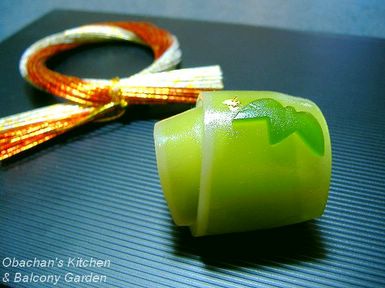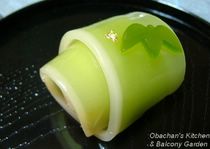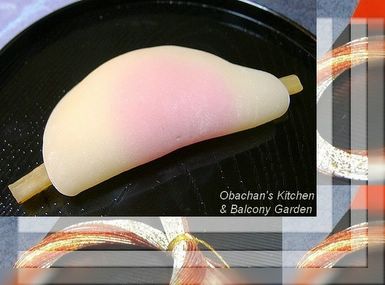
Wakatake (Young Bamboo)
In Japan, happy occasions are often celebrated with wagashi, and New Year’s holidays are no exception. At this time of the year, almost all Japanese confectionery shops sell wagashi that represent themes related to New Year’s celebration. They are often in the shape of the zodiac animal of the year, or animals/plants associated with good luck, such as crane, turtle, bamboo, pine and plum.
 Wakatake (young bamboo) is associated with good health, strength and endurance because it grows fast and remains green all year round. Gold leaf is often used for New Year’s wagashi to add a festive touch. Wakatake (young bamboo) is associated with good health, strength and endurance because it grows fast and remains green all year round. Gold leaf is often used for New Year’s wagashi to add a festive touch.
Read More--------

Hanabira-Mochi (Flower Petal Rice Cake)
Hanabira mochi is a traditional New Year’s wagashi with a long history. Its origin is a dessert called “hishi hanabira” which has been part of the traditional New Year’s dishes at shrines and the Imperial Court for hundreds of years. In olden days, they had a custom of eating certain chewy foods as part of their New Year’s ritual of wishing a long life. (The idea of “keeping good teeth” was associated with “living long"). Included in the chewy foods was oshi-ayu (sweetfish with its head and tail cut off). Eventually the ritual was simplified and they started eating special rice cakes called hishi hanabira instead of the original ritual foods. It is said that the sweetened burdock strip rolled in the hishi hanabira rice cake is the substitute for the oshi-ayu, and the miso added to the sweet bean paste also rolled in the rice cake is associated with zoni soup, another traditional New Year's dish.
This site has a hanabira mochi recipe with a photo showing inside of this elegant wagashi. (Scroll down and click to enlarge the photo.) Yes, the name “hishi (diamond shape) hanabira (flower petal)” came from the diamond-shaped pink rice cake inside. This wagashi has been used at the first tea ceremony of the year by urasenke school of tea ceremony since they got a permission from the Imperial Court about 100 years ago. Recently hanabira mochi has become popular among those who do not practice tea ceremony, too.
* Wagashi by Shingetsu
References:
http://www.yamakosenbei.co.jp/HAKU/hana.htm (Japanese)
and a few other sites.
Comments and corrections are welcomed.
|
![]()

![]()
7 comments:
thanks for the interesting link...homemade mochi...sounds interesting. have you ever done it?
My family used to make real mochi (from steamed mochigome) at home when I was a kid, but not any more. It was really a lot of work…
I have never tried making mochi with rice flour yet, but I’m going to give it a try sometime this month. It shouldn’t be too hard with the help of microwave.
yeah, when i was little i pounded some mochi in a giant vat with a wooden stick. it was fun for about three minutes...
Hi Obachan, I love your blog and would love to place a link to it on my own blog (which is mostly about knitting), please take a look and let me know what you think...by the way, I'm the person who made Stuffedster too. Thank you so much for making such great stuff and putting it online!
rae
We used to do that. But my dad couldn’t stand the back pain it gave him, so soon my family started borrowing an electric rice cake maker from one of our relatives.
e
Hi e,
Your site about knitting is sooooooooooooo cute! :D Feel free to link to my site. I feel flattered. To tell you the truth, I love knitting…or it’s more like, I can’t stop knitting once I start it. It’s a dangerous obsession to me.
Looks like your Stuffedster site is doing well, too. (I love that huge carrot!)
Hi Obachan - gorgeous wagashi and gorgeous pictures! My family used to make mochi as well - I still remember the exciting feeling as I was a child...
Yeah, I still remember how the hot mochi coated with mochitori-ko felt in my hands... :)
Post a Comment